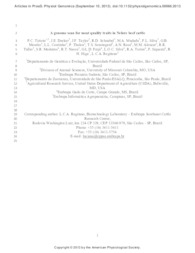Genome scan for meat quality traits in Nelore beef cattle.
Genome scan for meat quality traits in Nelore beef cattle.
Author(s): TIZIOTO, P. C.; DECKER, J. E.; TAYLOR, J. F.; SCHNABEL, R. D.; MUDADU, M. de A.; MOURAO, G. B.; COUTINHO, L. L.; THOLON, P.; SONSTEGARD, T. S.; ROSA, A. do N.; ALENCAR, M. M. de; TULLIO, R. R.; MEDEIROS, S. R. de; NASSU, R. T.; FEIJO, G. L. D.; SILVA, L. O. C. da; TORRES JUNIOR, R. A. de A.; SIQUEIRA, F.; HIGA, R. H.; REGITANO, L. C. de A.
Summary: Meat quality traits are economically important because they affect consumers' acceptance, which, in turn, influences the demand for beef. However, selection to improve meat quality is limited by the small numbers of animals on which meat tenderness can be evaluated due to the cost of performing shear force analysis and the resultant damage to the carcass. Genome wide-association studies for Warner-Bratzler shear force measured at different times of meat aging, backfat thickness, ribeye muscle area, scanning parameters [lightness, redness (a*), and yellowness] to ascertain color characteristics of meat and fat, water-holding capacity, cooking loss (CL), and muscle pH were conducted using genotype data from the Illumina BovineHD BeadChip array to identify quantitative trait loci (QTL) in all phenotyped Nelore cattle. Phenotype count for these animals ranged from 430 to 536 across traits. Meat quality traits in Nelore are controlled by numerous QTL of small effect, except for a small number of large-effect QTL identified for a*fat, CL, and pH. Genomic regions harboring these QTL and the pathways in which the genes from these regions act appear to differ from those identified in taurine cattle for meat quality traits. These results will guide future QTL mapping studies and the development of models for the prediction of genetic merit to implement genomic selection for meat quality in Nelore cattle.
Publication year: 2013
Types of publication: Journal article
Keywords: GWAS, QTL, beef cattle, zebu
Observation
Some of Embrapa's publications are published as ePub files. To read them, use or download one of the following free software options to your computer or mobile device. Android: Google Play Books; IOS: iBooks; Windows and Linux: Calibre.
Access other publications
Access the Agricultural Research Database (BDPA) to consult Embrapa's full library collection and records.
Visit Embrapa Bookstore to purchase books and other publications sold by Embrapa.

